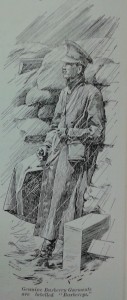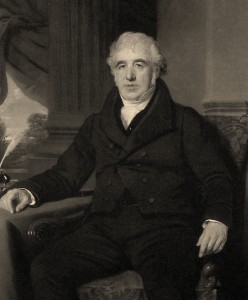The Weatherproof Fabric Trench Coat

Standing in a trench filling with water during a torrential downpour. Detail from Burberry advertisement, Canada Magazine an Illustrated Weekly Journal, January 1, 1916.
Everything the Officer Needs
Every day I visit with my computer and cross paths with a well-known search engine and its equally well-known doodle. Today was a surprise as the doodle has provided the impetus to make use of its content together with some of my own Great War research kept on hand for just such a serendipitous moment.
GOOGLE, today, featured Charles Macintosh whose birthday occurred 250 years ago this day. Macintosh, born in Glasgow, Scotland in 1766 is the inventor of waterproof fabric and today his name, given to the well known men’s garment, is perhaps not as well known as the coat itself. However, where, pray tell, can we take today’s Macintosh doodle and celebration and apply waterproof fabric and the garment to some aspect of the Great War?
Very simply…to bad weather and advertising of the day. In Canada Magazine, an Illustrated Weekly Journal there is amongst its pages several classified advertisements for men’s trench garments including those made by Kenneth Durward (Conduit Street, London); Robinson and Cleaver (Regent Street, London); Morris (Sackville Street, London) and Burberry (Haymarket, London, Basingstoke, also available from provincial agents and of course Paris). There may well be other manufacturers spread intermittently throughout the Canada Magazine’s pages but, for today, these names are a fine gathering of haberdashery, especially for officers on campaign.
Battle in the mud and rain. Scene from the Paul Gross film, Passchendaele, 2008.
The Tielocken advertisements by Burberry are accompanied by much internal and lavish praise from its manufacturer, “Such comprehensive security that every part of the body is kept warm, dry and comfortable during the prolonged exposure that campaigning entails…the favourite weatherproof amongst Officers…Officers wishing their Tielocken Coats to be ABSOLUTELY WATERPROOF, regardless of hygiene, may have them interlined [with] impervious material without extra cost.” The black and white line illustrations of the Burberry ads feature a dapper officer, shown in a distinctive modelling pose with or without trench system, with or without weather hardships. “IMPERVIOUS TO RAIN, SLEET, SNOW, OR WATER WET, BUT NOT AIR-TIGHT. PROOF AGAINST WIND. LUXURIOUSLY WARMING”. Price: £5 5s in serge or £6 6s in whipcord. Apart from the Tielocken other varieties of Burberry all weather gear, included the Trench Warm Burberry and the Trench Coverall Kit.
Competitor Morris, the Civil and Military Tailor established in 1890, spoke equally of their Morris Trench Coat, “Equipped with this splendid garment officers in the trenches are assured of perfect body comfort. Extreme weather conditions, cold, damp or wet cannot affect the wearer.” Featured materials included waterproof oilskin, wool plaid, camel (detachable lining) and cloth. Prices were offered at the same levels as Burberry’s but, Morris included the Canadian conversion prices at $25.50 and $30.65 respectively.
Kenneth Durward offered the Military Raincoat trench coat, made of the “Celebrated All Wool Durwardette” at 3 guineas, and the British Warm lined with camel fleece at 4 guineas. Durward trench coats were made of khaki materials lined with either fleece, sheepskin or fur and interlined with oilskin. In direct correspondence to today’s Macintosh anniversary doodle the Morris trench coat, with detachable camel fleece lining, could be worn as an ordinary Macintosh when the lining was removed. Apart from their premises at Ulster House, Conduit Street, London, visitors were further encouraged to stop by Durward’s Stall, # 113, at the Active Service Exhibition, Knightsbridge, London (March/April 1916). Interestingly although the guinea, had not been in production since 1816, the term remained in use for many years afterwards and 1 guinea represents a value of £1.05 or 21 shillings.
Robinson and Cleaver offered similar gear to the above manufacturers. Their three trench coats were available in Mark I, II and III formats not unlike model numbers of a Lee-Enfield rifle or bayonet! However, their pricing structure in contemporary advertisements likely left much to be desired by officers unfamiliar with guineas, pounds and shillings. At one time goods were priced in England with the pre-decimal currency of pounds, shillings and pence and further complicated with terms such as guineas and farthings. Although the value of a pound may have been mathematically easier to comprehend, the representation of Robinson and Cleaver prices in shillings at 75/- and 55/- must have raised a few eyebrows trying to work out the trench garment’s value in pounds and further converted into Canadian dollars [12 pence in a shilling, 20 shillings or 240 pence in a pound. 1 pound equal to about $5.00 Canadian].
It is also of interest to contemplate the per diem pay of the following ranks to estimate the time it may have taken to pay off accounts. Colonels $6.00 plus $1.50 field allowance; Lieutenant Colonels $5.00 plus $1.25 field allowance; Majors $4.00 plus $1.00 field allowance; Captains $3.00 plus .75¢ field allowance; Lieutenants $2.00 plus .60¢ field allowance. Although some serving officers certainly had the means to pay for these private purchases, without placing themselves “on account”, other officers must have taken time to pay once outfitted with the latest in goods.
So thanks to Mr. Charles Macintosh and especially thanks to today’s Google Doodle for choosing to celebrate Macintosh’s 250th birthday I have been able to rustle through my research and pull together a bit of corresponding trumpery for our musing. However, as always, I reiterate the value of returning repeatedly to valuable resources. There are gems in these journals and newspapers of the day, perhaps a line or two, a feature story or advertisement that just might encourage your hand within your fields of interest. Happy Birthday Mr. Macintosh and to all – Happy New Year no matter the weather and wherever you may be.


Comments